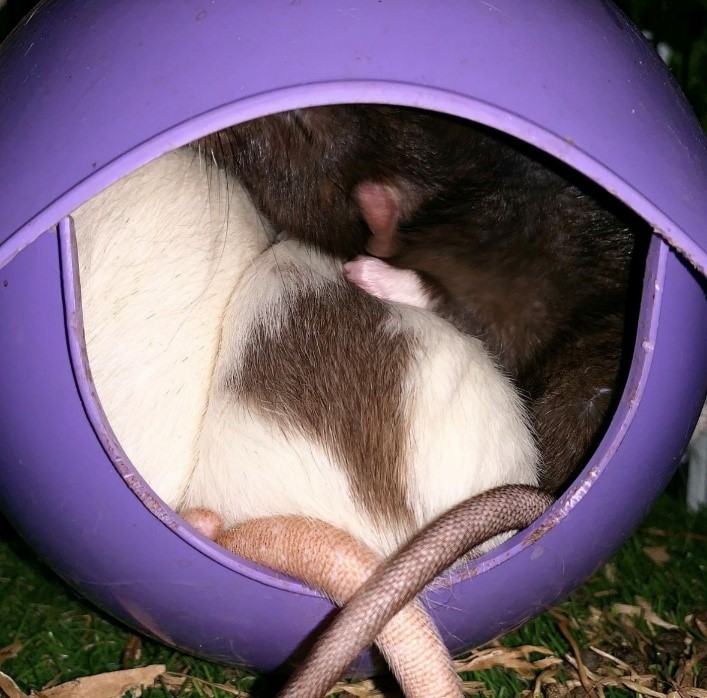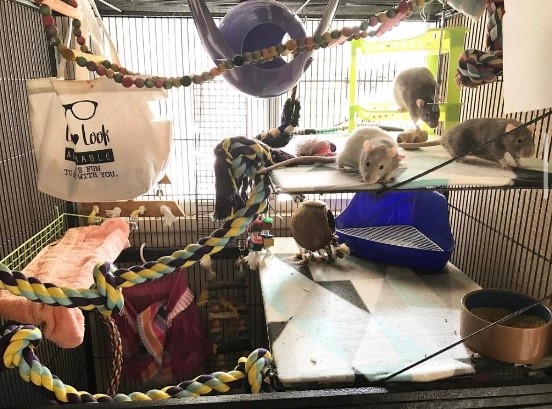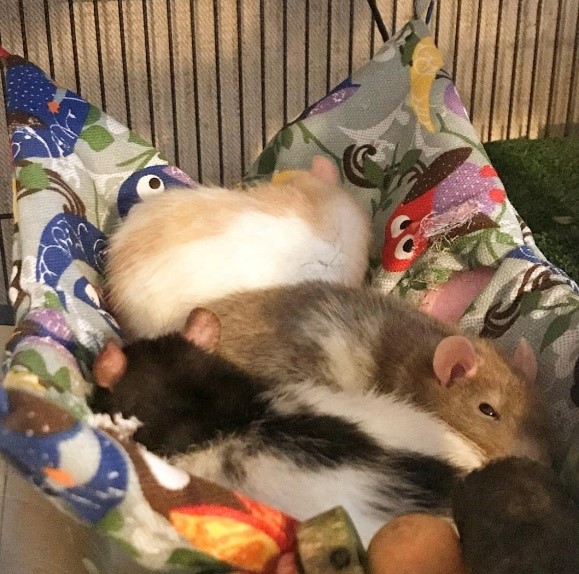What is environmental enrichment?
Environmental enrichment describes the provision of physical and social opportunities to promote rat behaviour that is important, valuable, and specific to them. It encourages and allows rats to do things that matter to them, resulting in positive experiences based on their individual interests, which underpins good animal welfare.
A key concept in environmental enrichment requires is that we know what rats like to do, also referred to as ‘species‐typical’ information. Then we can select enriching strategies that are behaviourally relevant and physically feasible for the rat. Designing an enrichment plan that is incompatible with the animals’ normal behaviour, physical attributes or their existing environment may not improve their wellbeing and could also cause frustration and potential harm.
So, what is a rat’s normal daily behaviour?
Normal behaviour
In general, rats are highly social animals. They usually nest together and often pile on top of one another, usually in a corner of their enclosure. (If there are any outcasts in the enclosure, they usually sleep separately from the group and may sleep in a more alert posture to allow them to easily monitor activity in the rest of the enclosure.)
Other very important and normal behaviours are chewing/gnawing, hiding, burrowing, grooming, nesting, feeling their way with their whiskers and the sensory fibres around their heads and shoulders, exploring, climbing, and seeking food. Note that rats are neophobic (afraid of new things to begin with); so, although it is important to give them new enrichment (e.g., items of food, new toys etc), often they will initially investigate these, then withdraw, or reject the enrichment but will often subsequently return to it once they have had time to get used to the new items or activities.

As rats are nocturnal / crepuscular species, they engage in the bulk of their behaviours at dusk, throughout the night, and in the early hours of the day.
Vision is their least-developed special sense. Their hearing and sense of smell are well developed and very important to them, and they appear to be able to sense ground vibrations. They also use their whiskers and the sensory fibres around their head and shoulders to help them find their way around (so, it is very important never to trim these).
Given their nocturnal / crepuscular nature and good sense of hearing, it is very important that rats have peace and quiet, the opportunity to sleep during the day, a dark area at night for their nocturnal activities. So, their enclosure should be situated somewhere quiet where they will not be disturbed and where they will get some hours of darkness (i.e., they should not be kept somewhere that is exposed to the light during both day and night such as in an area that humans light well at night and that is brightly lit during the day too).
Their sense of smell is very important to rats, so be aware that strong smells may disturb them, as may smells that might indicate a threat such as predators (this includes commonly kept companion animal species such as cats and dogs). In addition, anything that alters the smell of an individual mouse may cause social disturbances within your group of rats, including aggression. So, where possible avoid doing anything that will alter the smell of just one rat; for example, if you need to take one of your rats to the veterinarian, take the others too, or at least one of their enclosure-mates.
They spend considerable time exploring their enclosures and will climb over every available surface. It is not uncommon for them to also spend considerable time burrowing in their bedding or attempting to dig into the bottom of the enclosure. They initially investigate changes in their environment using their sense of smell. They hold their heads up in the air, sniffing away to identify the source of new odours. If that odour is unknown, they flare their nostrils and sniff faster, while moving around to better determine the source. If they recognize a threat, they may try to hide or escape.
They will spend a lot of time grooming themselves, licking their front paws and then wiping them over their face, body, and tail. They also spend a lot of time grooming their rat companions and this is an important social activity that builds and strengthens their relationships.
Rats locate their food by sniffing, grasp food with their mouths, sit on their haunches to eat, use their elbows to grasp the food, and manipulate it with their front feet as they are eating, even if the food is too large to be held in their paws.
They do not generally reserve a specific area for defecation, and faecal pellets are normally found throughout the enclosure and the bedding material. Rats practice coprophagia (eating their poo) which is a normal behaviour for them, but it is not required for nutritional reasons. Rats urinate at random in their enclosures, although not usually in their sleeping areas.
The type of behaviour exhibited by rats varies according to their individual interests, the type of environment, the age and sex of the rats, and their reproductive status.
Providing optimal environmental enrichment for rats
Environmental enrichment should commence while your rats are still young, so that they can experience good welfare. Providing good environmental enrichment can also help to prevent potential health and behavioural issues stemming from an inadequate environment.
Although they are very social animals, when rats are confined in enclosures, there are limits to the number of individuals that can co-exist peacefully and still display normal behaviours as described above. It is important that each animal have 1) an adequate amount of space and 2) the opportunity to perform species-typical behaviours and behaviours that they find rewarding (i.e., environmental enrichment).
What happens if we don’t provide appropriate enrichment?
Animals who can express species‐specific behaviours, and have choice, control, and problem-solving opportunities are more likely to experience good welfare. Because they are physically and mentally challenged in positive ways, they are less likely to feel frustrated or display abnormal behaviours. Rats who are not having positive experiences, and/or are having negative experiences, may display a range of abnormal or irrelevant behaviours, including:
- Aggression
- Hiding a lot or most of the time
- Chewing their enclosure bars
- Over-grooming
- Changing their feeding or toileting habits
- Drinking too much or playing with the water bottle
- Sitting hunched
- Reluctance to move
- Repeatedly circling their enclosure.
Lack of environmental enrichment can also lead to anorexia (or obesity) from stress, boredom, lack of stimulation, and general inactivity. Environmental enrichment should therefore be seen as a means of both preventing and, to an extent, treating these abnormal behaviours and an essential part of giving rats a good life.
If your rats are showing indications that they are not experiencing good welfare in the conditions they are living in, and your rat-savvy veterinarian has ruled out a health problem, then you need to re-evaluate their environment and your environmental enrichment plan.
Types of environmental enrichment
Environmental enrichment is much more than providing a few toys and an exercise wheel. Done properly, a good enrichment plan provides the opportunity for your rats to live a comfortable, low stress, and enjoyable life.
An enrichment plan should include some or all of the following:
- Foraging enrichment – the act of searching for and finding food.
- Social enrichment – the social interactions between your rats, and between your rats and people.
- Physical enrichment – ranging from objects placed in the enclosure for your rat to interact with, through to the environment as a whole (e.g., the space and quality of the environment available for your rats to do things they enjoy such as run, play, and chew).
- Sensory enrichment – uses the rats’ senses such as sight, hearing, smell, and touch.
- Occupational enrichment – items that elicit activities including exercise and problem solving, learning, and choosing and controlling some feature in their environment.
Examples of foraging enrichment include:
- Multiple food and water stations
- Food items can be hidden in foraging toys, hung from the enclosure, or hidden in bedding
- Food can be scattered over the floor of the enclosure
Examples of social enrichment include:
- Providing rats with the company of other rats, preferably of the same sex (or desexed) (see this article for more information)
- Supervised time out of the enclosure, spending time with you, including using reward-based training
- Try different activities and see what your rats enjoy. Once you know their preferences, you can pick a variety of activities they enjoy and give them the choice to engage in these with you regularly – making sure to change the activities frequently so they don’t get bored but bearing in mind their neophobia which, as explained earlier, can mean they need some time to get used to new experiences.

Examples of physical enrichment include:
- The enclosure
- Large enough to allow for exercise and tall enough for the rats to stretch or rear up
- Split flooring/multiple levels with carpeted ramps that provide rats access to shelving or other vertical spaces they enjoy
- Furniture
- Opportunities to dig/burrow e.g., deep trays filled with substrate
- Hammocks
- Hides and boxes, some with nesting material e.g., cut up clothing or towels
- Tubes and tunnels e.g., cardboard tubes from toilet paper, paper towels, rolled carpeting, PVC pipe, plastic tubing. These can be laid on the substrate, buried in/under it, or suspended above it.
- Ropes/branches/ladders to allow climbing exercise
- Exercise wheels, which must be the right type and size for your rats’ comfort and safety (look for rat specific ones) and ensure that the wheel does not have any sharp edges or anything that could catch a leg or tail and cause injury.
- Toys that can be chewed; e.g., wooden blocks, chew sticks, other wood toys, cardboard boxes and tubes, and branches of safe trees.


Examples of sensory enrichment include:
- Offering items with new or novel tastes and smells
- Rotating enclosure furniture
- Providing an appropriate day/night cycle
- Food items that have to be gnawed e.g., dog biscuits, nuts, etc.
Examples of occupational enrichment include:
- Providing materials so they can build a nest
- Positioning wood or cardboard blocks so they can gain access to another area by chewing
- Multi-tiered enclosures with connecting ramps
- Constructing mazes or burying tubing under bedding
- Rotating enclosure furniture on a regular basis
References
Girling S (2013) Small mammal husbandry, housing and rearing. In: Veterinary Nursing of Exotic Pets. John Wiley & Sons, Incorporated, Newark, pp 26–35
Banks RE, Sharp JM, Doss SD, Vanderford DA (2010) Enrichment. In: Exotic Small Mammal Care and Husbandry. Wiley, pp 11–19
Evans E (2006) Small rodent behaviour: mice, rats, gerbils, and hamsters. In: Bays TB, Lightfoot T, Mayer J (eds) Exotic Pet Behavior. W.B. Saunders, pp 239–261
Pilny AA (2015) Small Exotic Companion Mammal Wellness Management and Environmental Enrichment. Veterinary Clinics of North America – Exotic Animal Practice 18:245–254
